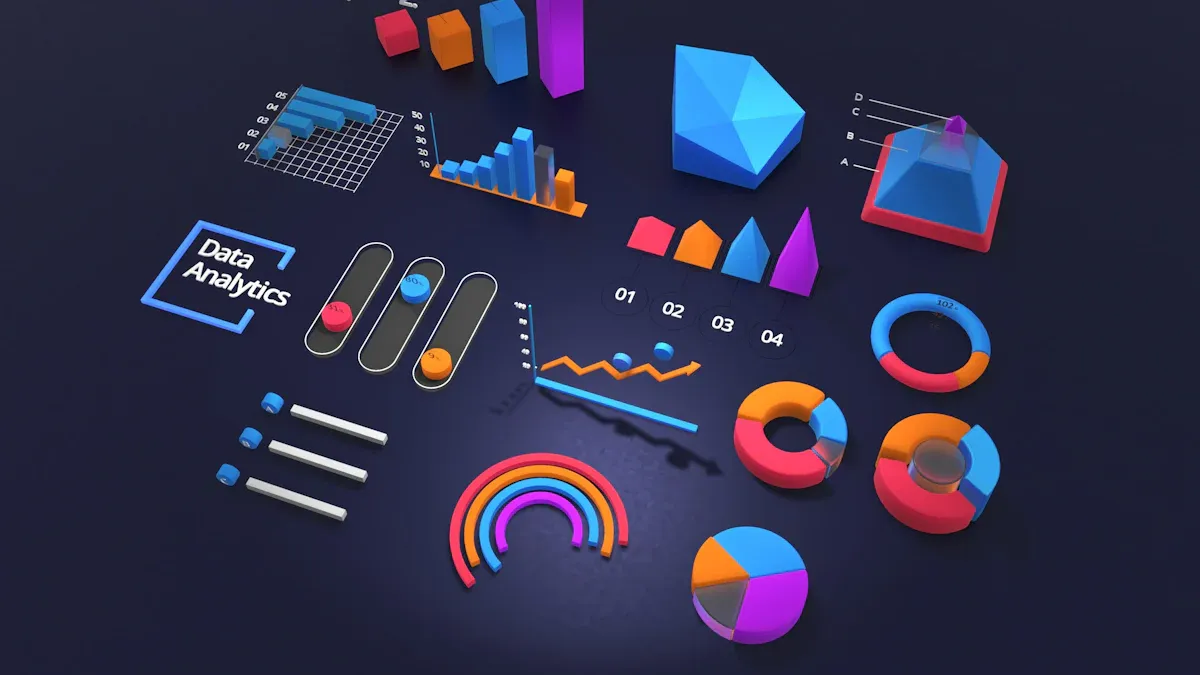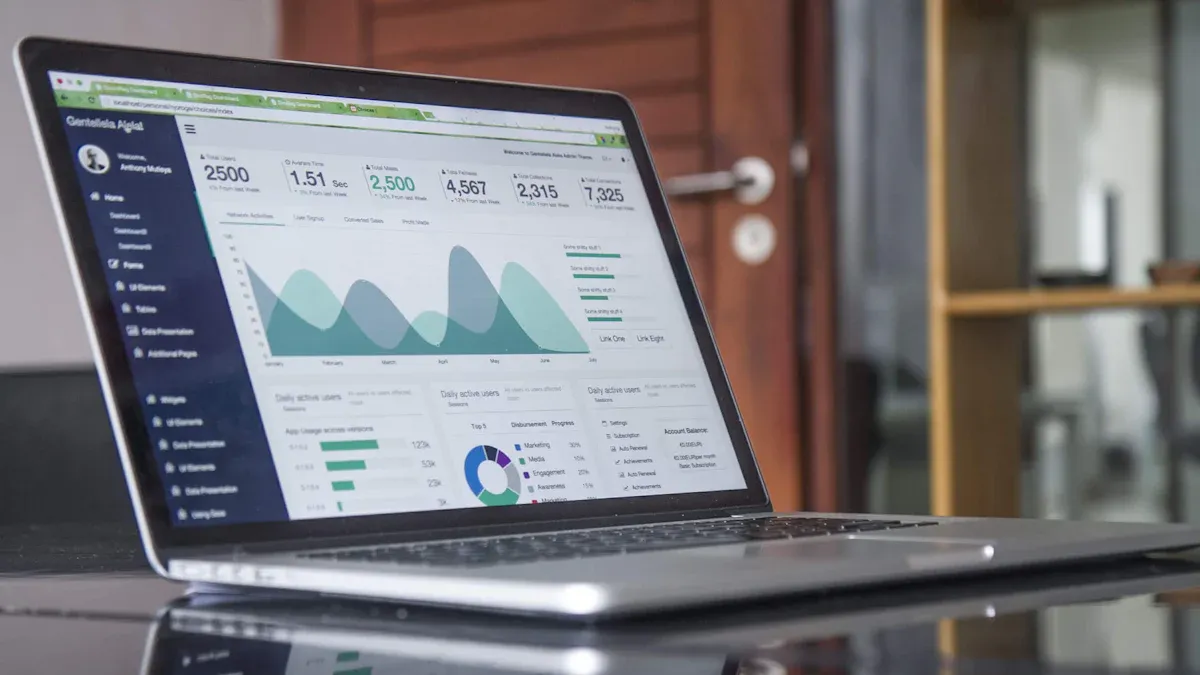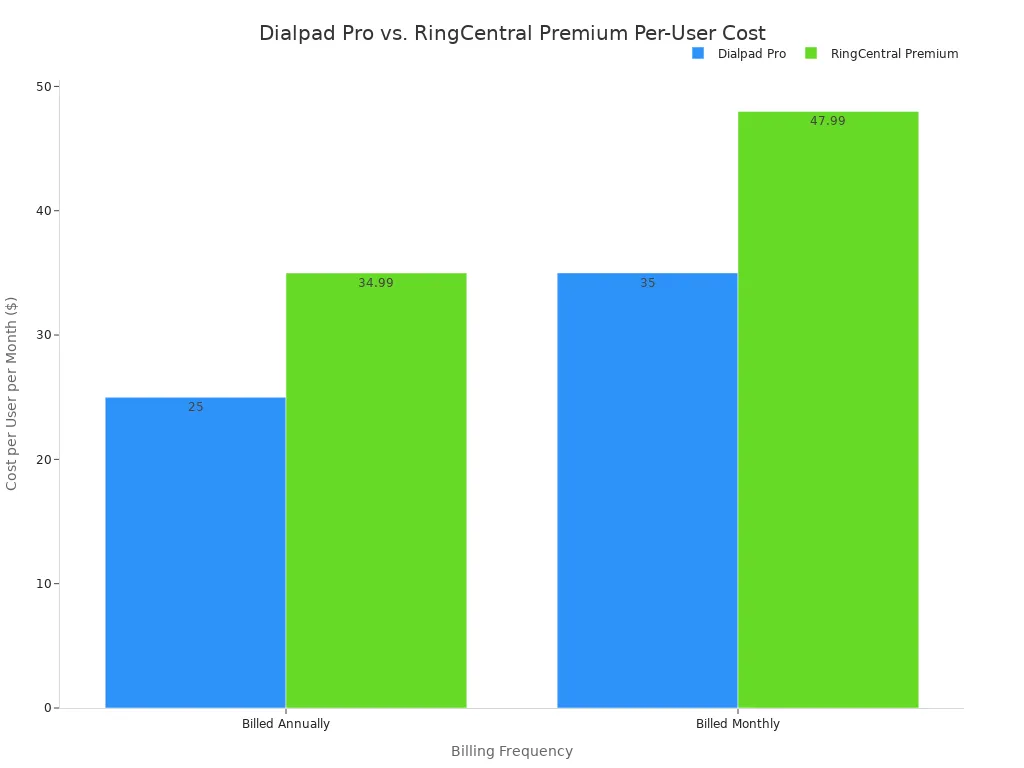Dialpad vs RingCentral Analytics A Full Comparison

The Dialpad vs. RingCentral decision hinges on your core analytics needs.
For businesses prioritizing AI-driven coaching and sentiment analysis, Dialpad offers a more advanced suite. For those needing comprehensive, traditional call reporting across a broader cloud-based communication platform, RingCentral provides a more robust solution.
The Sobot call center, powered by Sobot AI, presents a compelling alternative for unified call center data analytics. This stable platform from Sobot challenges both Dialpad and RingCentral, making the choice between Dialpad and RingCentral even more critical.
Dialpad vs. RingCentral: Key Analytics Features

When evaluating Dialpad vs. RingCentral, the analytics features reveal two distinct philosophies. Dialpad embeds AI deeply into its core, offering conversational intelligence from the ground up. RingCentral builds on its robust telecom foundation, providing powerful and highly customizable traditional reporting. Understanding these differences is key to choosing the right platform for your call center data analytics needs.
Real-Time Dashboards
Real-time dashboards provide managers with a live view of contact center operations. Both Dialpad and RingCentral offer this capability, but they focus on different types of information.
Note: A key difference lies in their standard dashboard offerings. Dialpad includes advanced reporting and analytics by default, while RingCentral features a dedicated Activity Dashboard.
| Feature | Dialpad | RingCentral |
|---|---|---|
| Reporting and Analytics | ✅ Yes | ❌ No (Standard) |
| Activity Dashboard | ❌ No | ✅ Yes |
Dialpad excels at providing live, AI-driven insights. Its dashboards feature real-time speech analytics, which analyzes calls as they happen. Supervisors can see live transcriptions and receive alerts for specific keywords. Dialpad AI even assists agents directly with pop-up notes and guidance. Heatmaps also show call volume trends, helping managers allocate resources effectively throughout the day.
RingCentral focuses on operational metrics. Its Activity Dashboard gives a clear, real-time overview of call activities. Managers can quickly see total call volume, average call duration, and the status of every agent. This approach is perfect for supervisors who need to monitor service levels and agent availability at a glance. This focus on real-time reporting helps teams stay on top of their queues.
AI-Powered Insights
Artificial intelligence is where the two platforms diverge most significantly. Dialpad makes its AI-powered features a central part of the user experience across most plans.
- Dialpad: Its native Voice Intelligence (Vi™) engine provides sentiment analysis, real-time agent coaching, and automated post-call summaries. This technology helps identify customer frustration, ensures script adherence, and reduces manual work for agents. Dialpad builds these tools directly into its platform.
- RingCentral: While RingCentral also offers AI capabilities, they often come as part of its higher-tier plans or through integrations. Its AI tools are powerful, providing conversation analytics, automated scoring, and topic extraction. However, the strength of RingCentral lies more in its comprehensive call management system than in native, entry-level AI.
For businesses seeking to leverage AI for immediate coaching and quality assurance, Dialpad presents a more integrated solution.
Historical Reporting
Historical reporting is crucial for understanding long-term trends and making strategic decisions. Here, RingCentral demonstrates its strength with deep customization and data retention options.
RingCentral offers a more traditional but powerful reporting suite. It provides eight pre-built report templates that cover key business metrics and network performance. For users on its Ultra plan, RingCentral offers up to 12 months of analytics and reporting history, giving businesses a long-term view of their performance.
Dialpad, on the other hand, provides a modern interface with reports like its 'Charting Data report.' However, its data retention policies can be a concern for some. The default retention for call recordings is 30 days unless an extension is purchased. This shorter window may not be sufficient for organizations needing extensive historical data for compliance or analysis. The call analytics provided by Dialpad are visually appealing but may offer less raw data customization than RingCentral.
Agent Performance Metrics
Both platforms provide essential tools for tracking agent performance, but they use the data in different ways.
RingCentral allows managers to create detailed, custom reports on nearly any metric. You can track an agent's answered calls, average handle time, and first-call resolution rate with precision. These reports are ideal for formal performance reviews and identifying team-wide training needs.
Dialpad uses performance data to fuel its real-time coaching. While managers can pull reports on agent activity, the platform's unique value is its ability to show why certain metrics are high or low. For example, sentiment analysis can reveal if an agent with a long handle time is successfully de-escalating complex issues, adding valuable context beyond the numbers.
Call Quality Monitoring
Maintaining clear, reliable call quality is non-negotiable. Both platforms offer tools to ensure a stable connection.
Dialpad users consistently report high Mean Opinion Scores (MOS), a standard measure for voice quality. The platform is engineered to deliver clear audio without common issues like jitter or latency, ensuring a professional customer experience. This focus on inherent quality means managers spend less time troubleshooting technical problems.
RingCentral leverages its extensive telecom infrastructure to provide exceptional reliability. It gives administrators detailed network performance reports, including metrics on jitter, latency, and packet loss. This allows IT teams to proactively identify and resolve potential network issues before they impact customers, making RingCentral a very dependable choice for large-scale operations.
Ease of Use and User Interface

A platform’s user interface determines how easily teams can access powerful analytics. Both Dialpad and RingCentral offer distinct user experiences. The choice depends on a team's preference for modern design versus traditional functionality.
The Dialpad User Interface
The Dialpad platform presents a clean and modern interface. Users often find Dialpad intuitive from the start. Its design consolidates calls, messages, and meetings into a single application. This unified approach simplifies navigation. Agents can access analytics and real-time coaching tools without switching screens. The layout helps users quickly find the information they need.
The RingCentral User Interface
RingCentral provides a feature-rich and highly functional interface. The RingCentral design is more traditional. It gives users deep control over a wide range of communication tools. While powerful, new users may need more time to learn the RingCentral system. The platform separates different functions into tabs, which keeps the workspace organized for experienced users. RingCentral offers a very comprehensive experience.
Onboarding and Deployment Time
Onboarding speed is a critical factor for many businesses. A faster setup means a quicker return on investment.
Teams can often deploy Dialpad in a matter of hours. The simple setup process allows administrators to configure settings and add users with minimal effort. In contrast, RingCentral can have a longer deployment time. The extensive customization options available in RingCentral require more planning and configuration. This makes RingCentral a better fit for enterprises with dedicated IT support.
Data Visualization and Clarity
Both platforms present data effectively, but with different styles. Dialpad uses colorful charts and heatmaps. These visuals make it easy to spot trends at a glance. The visual style of Dialpad appeals to users who prefer a graphical summary.
RingCentral focuses on detailed, table-based reports. The data presentation in RingCentral is clear and precise. This format is ideal for managers who need to export raw data for deep analysis. The RingCentral approach prioritizes detail over visual flair.
An Alternative to Consider: Sobot's Voice/Call Center

While Dialpad and RingCentral offer strong analytics, Sobot's Voice/Call Center emerges as a powerful, all-in-one alternative. It is designed for businesses seeking a stable and unified solution. Sobot provides robust analytics within a comprehensive contact center platform.
Sobot's Unified Analytics Workspace
Sobot offers a unified workspace that brings all customer interactions together. This system consolidates data from calls, live chat, email, and social media into one place. Agents and managers get a complete view of the customer journey. This integrated approach simplifies call center data analytics. Teams can analyze trends across all channels, not just voice. This leads to smarter decisions and better customer engagement.
Real-Time Monitoring and Analysis
Sobot delivers powerful real-time monitoring tools for global teams. Managers can track live call data and agent performance from a central dashboard. The platform also supports analysis based on different time zones, a key feature for international operations. A major advantage is its system stability.
- Sobot's voice system maintains a normal operational time of approximately 99.99%.
- The platform guarantees a 99.99% SLA, ensuring dependable service.
This high level of reliability means businesses can trust their communication infrastructure to be available when they need it most.
Sobot's Approach to Call Center Data Analytics
Sobot’s approach to call center data analytics focuses on providing clear, actionable insights. The platform moves beyond basic metrics. It helps managers understand the story behind the numbers. Detailed dashboards and comprehensive reports make it easy to monitor, analyze, and optimize operations. This focus on practical call analytics helps teams improve efficiency and service quality. Sobot is a leader among ai-powered contact centers.
AI-Powered Voicebot and IVR Analytics
Sobot enhances its analytics with advanced AI. The AI-powered Voicebot uses several core technologies to deliver intelligent, human-like interactions.
- It leverages Automatic Speech Recognition (ASR), Natural Language Processing (NLP), and Large Language Models (LLM).
- The inbound Voicebot can handle over 50% of customer interactions instantly.
- The outbound Voicebot uses AI agents for automated marketing, which can improve sales.
This technology provides deep insights into IVR navigation and customer intent. It allows businesses to analyze and optimize automated interactions for a smoother customer experience.
Integration and Analytics Enhancement
Integrations expand the power of unified communications solutions. Connecting your platform to other business tools creates a richer data ecosystem. Both Dialpad and RingCentral offer integrations, but their approaches and capabilities differ.
CRM and BI Tool Connectivity
Connecting to a CRM is essential for contextual call analytics. Both Dialpad and RingCentral provide native integrations for popular platforms. However, RingCentral offers a wider range of native connections to specialized CRMs.
| CRM Integration | Dialpad | RingCentral |
|---|---|---|
| Salesforce | Native | Native |
| HubSpot | Native | Native |
| Kustomer | Native | N/A |
| Microsoft Dynamics | Native | Native |
| ServiceNow | Native | Native |
| Slack | Native | N/A |
| Zendesk | Native | Native |
| Zoho | Native | Native |
| Bullhorn | N/A | Native |
| Freshdesk | N/A | Native |
| Jack Henry | N/A | Native |
| Oracle NetSuite | N/A | Native |
| SugarCRM | 3rd Party | Native |
Comparing API Access
The number of available third-party applications shows a platform's ecosystem maturity. While both platforms offer key integrations, their app galleries show a slight difference in scale.
| Platform | Number of Integrations |
|---|---|
| Dialpad | 21 |
| RingCentral | 18 |
While Dialpad has a slightly larger number of listed integrations, the depth of RingCentral's connections in the enterprise space is notable.
RingCentral's Integration Advantage
The advantage for RingCentral lies in its deep-rooted connections with enterprise-level software. RingCentral supports native integrations for industry-specific CRMs like Bullhorn and Jack Henry. This makes RingCentral a strong choice for larger organizations with established software stacks. The platform's focus on robust, native connections simplifies the process of building a comprehensive cloud-based communication system. For many businesses, the native support from RingCentral is a key decision factor.
How Integrations Boost Native Analytics
Integrations transform raw data into actionable business intelligence. They provide a complete picture of customer interactions, enhancing call center data analytics.
A great example is how TechnologyOne used RingCentral integrations. By connecting RingCentral with Salesforce, the company automated call logging and gained deeper visibility into agent performance. This integration improved their ability to make staffing decisions. The native RingCentral Analytics Portal provided insights that helped the team resolve issues proactively. This shows how a well-integrated RingCentral system elevates a company's analytics capabilities beyond what the platform can do alone. The Dialpad platform also benefits from integrations, but the RingCentral ecosystem is built for this kind of deep enhancement.
Pricing and Analytics Feature Access
The cost of a platform directly impacts which analytics features a business can access. Both Dialpad and RingCentral gate their most powerful tools behind higher-priced tiers. Understanding this structure is key to choosing the right solution for your budget.
Unlocking Analytics in Dialpad Tiers
Dialpad provides analytics features at different levels. The base plan from Dialpad includes useful tools like call transcriptions. However, Dialpad locks its most powerful AI analytics behind more expensive premium plans.
Businesses must upgrade to unlock the full potential of the platform. For example, real-time sentiment analysis and AI-powered coaching are only available on the Support or Sell plans. This means a higher investment is necessary to access the advanced insights that Dialpad promotes.
Accessing Analytics in RingCentral Tiers
RingCentral also ties its advanced analytics to its upper-tier plans. To get customizable historical reporting, users need to look beyond the basic packages. The RingCentral Conversation Intelligence plan offers personalized reporting tools and multi-level reports. This plan starts at $60 per user per month. It provides AI-driven coaching and performance analysis. The structure of RingCentral requires a significant commitment for deep analytics.
Value Proposition for Small Businesses
Small businesses must weigh cost against features carefully. The entry-level plans for both Dialpad and RingCentral offer different value. A comparison of mid-tier plans shows a clear price difference. The Dialpad Pro plan is more affordable than the RingCentral Premium plan.
| Plan | Billed Annually (per user/month) | Billed Monthly (per user/month) |
|---|---|---|
| Dialpad Pro | $25 | $35 |
| RingCentral Premium | $34.99 | $47.99 |

This makes Dialpad an attractive option for teams on a tighter budget.
Cost for Enterprise-Grade Analytics
Accessing enterprise-grade analytics on either platform requires a premium subscription. For Dialpad, this means moving to the highest tiers to use its signature AI features. For RingCentral, it involves subscribing to plans that unlock its deep, customizable reporting suite. The total cost for top-level analytics from RingCentral can be higher. However, many large businesses find the investment in the RingCentral ecosystem worthwhile for its robust capabilities.
The Dialpad vs. RingCentral choice depends on your primary goal for call center data analytics. Dialpad offers cutting-edge AI for real-time coaching. RingCentral provides an enterprise-grade hub with powerful reporting. The Dialpad platform is a strong choice for sales teams. Another option, Dialpad, focuses on live agent assistance.
For businesses seeking a stable, all-in-one solution with a unified workspace and strong global support, Sobot's Voice/Call Center presents a compelling alternative worth exploring. Your final decision on Dialpad or RingCentral should align with your team's specific needs.
FAQ
Which platform is better for AI analytics?
Dialpad integrates AI features like real-time coaching and sentiment analysis across more of its plans. It is a strong choice for teams that want AI-driven insights out of the box. RingCentral offers powerful AI, but often in its higher-priced tiers or through integrations.
Which platform offers better historical reporting?
RingCentral provides more robust and customizable historical reporting. Its higher-tier plans offer longer data retention periods, making it ideal for businesses that need deep, long-term analysis. Dialpad's reporting is more visual but has shorter default data retention limits.
Is Dialpad or RingCentral more affordable for a small business?
Dialpad's entry-level and mid-tier plans are generally more affordable than RingCentral's comparable offerings. For small businesses on a budget, Dialpad often presents a lower starting cost for access to its communication and analytics tools.
What makes Sobot a good alternative?
Sobot offers a stable, all-in-one solution with a unified workspace. It combines interactions from all channels for complete call center data analytics. With 99.99% uptime and features for global teams, it provides a reliable and comprehensive platform for customer communications.
See Also
Evaluating Artificial Intelligence Solutions for Enterprise Call Centers Effectively
The 10 Best Call Center Analytics Software Platforms for 2024
Your Comprehensive Guide to Omnichannel Call Center Software Solutions
Reviewing the Leading Automated Voice Calling Software Options for 2024
An In-Depth Review of the Best Contact Center Solutions in 2024
